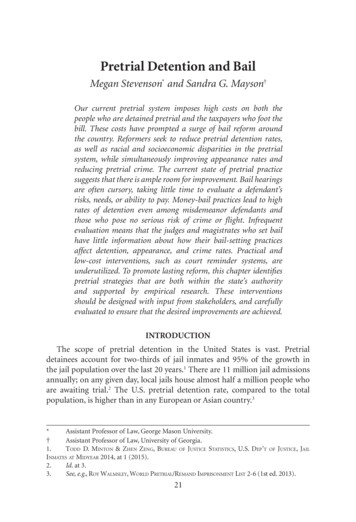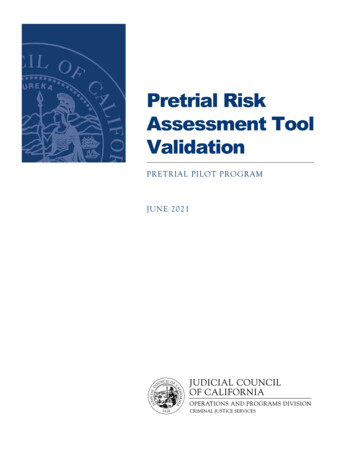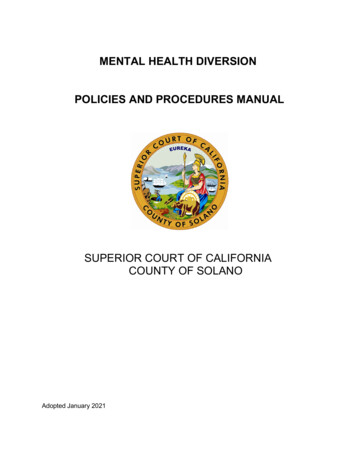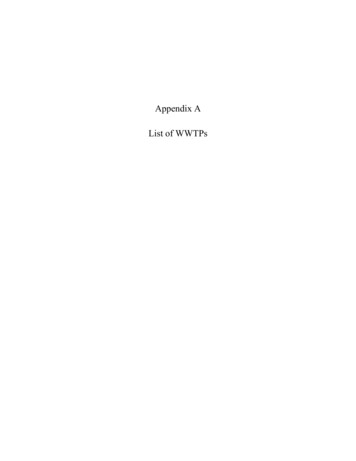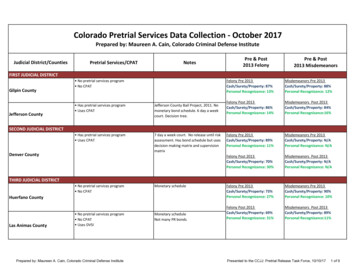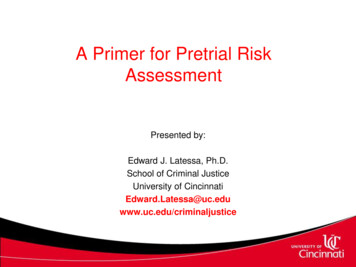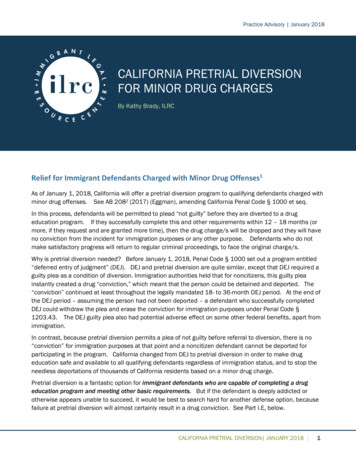
Transcription
Practice Advisory January 2018CALIFORNIA PRETRIAL DIVERSIONFOR MINOR DRUG CHARGESBy Kathy Brady, ILRCRelief for Immigrant Defendants Charged with Minor Drug Offenses1As of January 1, 2018, California will offer a pretrial diversion program to qualifying defendants charged withminor drug offenses. See AB 2082 (2017) (Eggman), amending California Penal Code § 1000 et seq.In this process, defendants will be permitted to plead “not guilty” before they are diverted to a drugeducation program. If they successfully complete this and other requirements within 12 – 18 months (ormore, if they request and are granted more time), then the drug charge/s will be dropped and they will haveno conviction from the incident for immigration purposes or any other purpose. Defendants who do notmake satisfactory progress will return to regular criminal proceedings, to face the original charge/s.Why is pretrial diversion needed? Before January 1, 2018, Penal Code § 1000 set out a program entitled“deferred entry of judgment” (DEJ). DEJ and pretrial diversion are quite similar, except that DEJ required aguilty plea as a condition of diversion. Immigration authorities held that for noncitizens, this guilty pleainstantly created a drug “conviction,” which meant that the person could be detained and deported. The“conviction” continued at least throughout the legally mandated 18- to 36-month DEJ period. At the end ofthe DEJ period – assuming the person had not been deported – a defendant who successfully completedDEJ could withdraw the plea and erase the conviction for immigration purposes under Penal Code §1203.43. The DEJ guilty plea also had potential adverse effect on some other federal benefits, apart fromimmigration.In contrast, because pretrial diversion permits a plea of not guilty before referral to diversion, there is no“conviction” for immigration purposes at that point and a noncitizen defendant cannot be deported forparticipating in the program. California changed from DEJ to pretrial diversion in order to make drugeducation safe and available to all qualifying defendants regardless of immigration status, and to stop theneedless deportations of thousands of California residents based on a minor drug charge.Pretrial diversion is a fantastic option for immigrant defendants who are capable of completing a drugeducation program and meeting other basic requirements. But if the defendant is deeply addicted orotherwise appears unable to succeed, it would be best to search hard for another defense option, becausefailure at pretrial diversion will almost certainly result in a drug conviction. See Part I.E, below.CALIFORNIA PRETRIAL DIVERSION JANUARY 20181
CALIFORNIA PRETRIAL DIVERSIONThis Advisory first will discuss how pretrial diversion under amended Penal Code §1000 (2018) works andits effect on immigration issues. Then it will discuss how to deal with prior DEJ adjudications under the oldversion of § 1000 (1997-2017), including use of Penal Code § 1203.43 to erase the “conviction.” See alsogeneral discussion of how to deal with immigration and drug issues, online at Note: Controlled Substances. 3Pretrial Diversion Under Penal Code § 1000 (January 1, 2018)I.A. Overview: Pretrial DiversionPretrial Diversion under amended Penal Code § 1000 et seq. is very similar to former Deferred Entry ofJudgment (DEJ) under the same statute. In both cases, a defendant who is charged with one or moreminor, non-trafficking drug offenses, such as possession of a controlled substance, and who does not have adisqualifying criminal record or current charge, can agree to be diverted from the criminal case into a civildrug treatment or education program. If the person successfully completes the diversion program, the drugcharges are dropped and the person has (or in the case of DEJ, was supposed to have) a completely cleanslate: he or she has (or was supposed to have) no conviction, and with some important exceptions can evendeny having been arrested.Pretrial diversion differs from DEJ in a few key ways: The defendant will enter a plea of not guilty before accepting diversion. (DEJ required a guilty pleabefore diversion, which created a conviction for immigration purposes.) At the same time, the defendant must waive the right to trial by jury in the criminal case. That meansthat if the defendant fails the pretrial diversion program, a jury trial will not be an option when he orshe returns to court to continue with the criminal case. (The right to jury trial was not relevant to DEJ,since the person already had pleaded guilty.) The diversion period, which is the time within which the defendant is monitored and must completediversion conditions and follow other rules, is 12 to 18 months. Someone who needs additional timeto complete the program may request it. (DEJ had a period of 18 to 36 months.) The bars to eligibility for pretrial diversion were changed slightly from DEJ, to permit more people toparticipate. See Part C.B. What Offenses Qualify for Treatment in Pretrial Diversion?The list of qualifying drug offenses is the same for pretrial diversion as it was for DEJ. The first paragraph ofPenal Code § 1000(a) includes 14 qualifying code sections. These mainly relate to simple possession, beingunder the influence, and possession of paraphernalia. They also include soliciting, or obtaining a drug byfictitious prescription, for personal use only (Cal H&S C § 11368, Cal PC § 653f), as well as growingmarijuana for personal use only (Cal H&S C § 11358). See list of offenses at the end of this Advisory.C. What Defendants Qualify to Participate in Pretrial Diversion?A defendant’s current charges or past criminal record can disqualify him or her from participating in pretrialdiversion. Amended Penal Code § 1000(a)(1)-(4) provides the following requirements for eligibility:2 JANUARY 2018
CALIFORNIA PRETRIAL DIVERSION1) “Within five years prior to the alleged commission of the charged offense, the defendant has notsuffered a conviction for any offense involving controlled substances other than the offenseslisted in this subdivision.”In other words, if the defendant was convicted of a drug offense within the last five years, it musthave been for the type of offense that can be treated in pretrial diversion (e.g., simplepossession), or else the defendant is barred. A controlled substance conviction from more thanfive years ago is not a bar.2) “The offense charged did not involve a crime of violence or threatened violence.”3) “There is no evidence of a contemporaneous violation relating to narcotics or restricteddangerous drugs other than a violation of the offenses listed in this subdivision.”4) “The defendant has no prior felony conviction within five years prior to the alleged commission ofthe charged offense.”These bars to eligibility for pretrial diversion are somewhat more forgiving than the bars to DEJ were. Alongwith the above, the DEJ statute barred defendants who had any prior drug conviction, a diversion within theprior five years, or an unresolved probation violation. See former § 1000(a). In contrast, the pretrialdiversion statute is informed by research that shows that an ultimately successful recovery from addictionoften includes relapses, so that it is in the public interest to not limit diversion eligibility so severely.D. How Does Successful Participation in Pretrial Diversion Affect Immigration Status?California amended Penal Code § 1000 to create pretrial diversion with the goal of permitting all residents,including noncitizens, the opportunity to safely take advantage of a diversion program. The goal is to ensureas much as possible that there are no immigration consequences. This section will discuss the need to getlegal advice before dealing with immigration authorities, the need to admit to the arrest on forms, and thelegal bases for why pretrial diversion does not make a noncitizen deportable or inadmissible.Dealing with immigration authorities after diversion. The rest of this section explains why pretrial diversionshould not have any adverse immigration consequences. Even so, every person who has gone through adiversion program should seek immigration advice before they leave the U.S. on a trip, or submit anyimmigration application. The person needs to know if some law or policy may have changed, and also mayneed protection in case the authorities wrongly charge that they are removable. As long as immigrationlaws impose such terribly harsh penalties for minor drug issues, it is worth it to get expert legal advice.How to answer questions on an immigration form. Section 1000.4, under both DEJ and pretrial diversion,states that a person who was found to have completed the program is permitted to state that the arrestnever took place. That is not the rule when completing federal immigration forms. If an immigration formasks whether the person was arrested, she must include the arrest (if any) that led to pretrial diversion orDEJ. Otherwise the person can be accused of not telling the truth on the form.Immigration effect of pretrial diversion. This section discusses why pretrial diversion does not make anoncitizen deportable and/or inadmissible. In this context, those terms are defined as follows: The term “deportable” means a condition, conduct, or criminal conviction that could cause a nonU.S. citizen to lose the lawful immigration status that she already has. For example, it could cause a JANUARY 20183
CALIFORNIA PRETRIAL DIVERSIONlawful permanent resident (“green card”-holder) to lose her green card and be deported (forced toleave the U.S., usually permanently). The term “inadmissible” means a condition, conduct, or criminal conviction that can cause a nonU.S. citizen to be unable to get some new lawful immigration status or other benefit, or to beadmitted at the U.S. border. For example, it could cause an undocumented person who is married toa U.S. citizen and has U.S. citizen children to lose the ability to get a green card based on family.The grounds relating to controlled substances are:Deportable or inadmissible drug “conviction.” A noncitizen can be found deportable and inadmissible ifconvicted of an offense relating to a federally-defined controlled substance.4 Pretrial diversion does notresult in a “conviction” for immigration purposes, because there is no plea or finding of guilt. See PenalCode § 1000.1(b), and immigration definition of conviction at INA § 101(a)(48)(A), 8 USC § 1101(a)(48)(A).Inadmissible for formally admitting having committed a drug offense. A noncitizen can be foundinadmissible if she formally admits committing all of the elements of a crime relating to a federally-definedcontrolled substance.5 There are strict technical requirements for such admissions.Participating in pretrial diversion does not require a guilty plea, so there is no admission there. Further, evenif the person were to admit the drug conduct later in other venues – for example, to a probation officer, drugcounselor, or immigration judge– this should not make the person inadmissible. The Board of ImmigrationAppeals held that if conduct was brought before a criminal court judge and the disposition was less than aconviction – as it is with pretrial diversion -- then the person cannot be found inadmissible based onadmitting that conduct.6 Still, the best course is to decline to admit such conduct when possible, outside ofconfidential treatment, unless an immigration attorney has stated that it is safe to do so.Inadmissible or deportable drug addict or abuser. A person is inadmissible if she is currently a drugaddict or abuser, and deportable if she ever was one since she was admitted to the U.S.7 Whether someoneis a drug addict or abuser is a medical determination. As with the rest of these grounds, the drug in questionmust be a controlled substance listed on federal schedules.The fact that a person participated in DEJ or pretrial diversion does not prove that she is a drug abuser. Incontrast to some drug court systems, which require defendants to admit that they are “in danger ofbecoming an addict,” pretrial diversion does not require defendants to admit that they ever have used drugsat all. It is not evidence of abuse or addiction. But the fact that the person received diversion might sparkmore questioning by officers, and this is yet another reason to consult with immigration counsel before filingan application or leaving the country.Perils of drug trafficking. A trafficking offense is a bar to both DEJ and pretrial diversion, so the issuemay not be directly presented with these clients. However, counsel can help their clients by warning themthat any drug trafficking conduct can have terrible immigration consequences. A conviction for drugtrafficking (e.g., possession for sale of 20 worth of drugs), manufacture (e.g., growing marijuana forpersonal use, H&S C § 11358), or certain other state offenses that are analogous to federal drug felonies,all are “aggravated felony” convictions that carry the worst possible immigration consequences; theyessentially guarantee deportation.8 Even without a conviction, a noncitizen is inadmissible (although notdeportable) if immigration authorities have substantial and probative “reason to believe” that the personever aided, assisted, or participated in any drug trafficking, or if within the last five years the personbenefitted from an inadmissible spouse or parent’s trafficking.9 Trafficking is very damaging to refugees4 JANUARY 2018
CALIFORNIA PRETRIAL DIVERSIONand asylees. Criminal defense counsel have some strategies to protect immigrant defendants charged withdrug trafficking,10 but the bottom line is that this is extremely dangerous conduct for a noncitizen.E. How Does Unsuccessful Participation in Pretrial Diversion Affect Immigration Status;What to Do with Nonfunctional ClientsA noncitizen defendant who may not be able to complete the requirements of pretrial diversion shouldseriously consider declining diversion and seeking other defense options. The stakes are high. A personwho fails pretrial diversion is very likely to receive a drug conviction. This may put the person at immediaterisk of detention, deportation, and permanent banishment from their life and family in the United States. Forthis reason, it is critical for defense counsel, the immigrant defendant, and their family to talk frankly beforedeciding to accept pretrial diversion.Having said that, for other immigrant defendants, diversion is an extremely good choice. A defendant who ismotivated to stay in the U.S. and who is relatively functional is likely to succeed. The drug educationrequirements are not onerous. The person may be monitored to ensure that she is not using drugs and ismeeting other requirements, although depending on the court, there may be patience for mistakes andsetbacks for some period of time. If successful, the defendant will come out with no criminal convictionand no adverse immigration consequences.Pretrial diversion operates as follows. After a court diverts a defendant’s case, it will continue to monitorwhether the defendant is satisfactorily progressing in the diversion program. (This process is unchangedfrom the DEJ statute). If the court ultimately finds that the defendant has not performed satisfactorily, thecourt will terminate diversion and the defendant will face the original criminal charges. The defendant likelywill be convicted of a drug offense for immigration purposes (either in a regular criminal proceeding orthrough Proposition 36). In the majority of minor drug cases, the witness is a police officer who was at thescene, and there is little defense to mount. The defendant will have waived her right to jury trial as acondition of entering diversion, so the defense will lack that leverage. It is possible that defense counselcan persuade the prosecutor to make some compromise or succeed at a court trial, but the client should beprepared for the worst.If the defendant will not accept pretrial diversion, the goal is to negotiate a plea to a non-drug offense that isnot harmful to immigration status. This brings up the larger issue of how to conduct the criminal defense ofa noncitizen. To identify a safer plea, one must make an individual analysis for each client, based upon theperson’s current immigration status, possible eligibility for status or relief, analysis of all prior convictions,and other factors. Among other variables, each application for immigration status or relief can be barred bydifferent offenses, so that an offense that is harmless for one immigrant is terrible for another. (Forinformation on various applications and their bars, see the ILRC Relief Toolkit at www.ilrc.org/chart.) Thereare many written resources available to help in this endeavor. However, for counsel who have not spenttime gaining this expertise, the easiest and best way to do this is to speak with a crim/imm expert. Notethat this area often contradicts common sense. Some California felonies, including strikes, can have no orfew immigration consequences, while some misdemeanors, even with no custody time imposed, can be fatalin the wrong situation. For free online advisories and practice aids, go to www.ilrc.org/crimes andwww.ilrc.org/chart. Because the law changes frequently, note the date of publication of each resource andbe prepared to check for updates. JANUARY 20185
CALIFORNIA PRETRIAL DIVERSIONII.Dispositions under Deferred Entry of Judgment, Penal Code § 1000 (1997-2017)Between January 1, 1997 and December 31, 2017, a defendant charged with a minor drug offense mayhave been offered Deferred Entry of Judgment (DEJ) under the version of Penal Code § 1000 et seq. ineffect at that time. A qualifying defendant would plead guilty and be diverted to a civil drug education ortreatment program. Section 1000.1(d) provided that the guilty plea was “not a conviction for any purpose,”unless a judgment was entered based on failure in the program. If after 18 to 36 months the court foundthat the defendant had performed satisfactorily, the judge would dismiss the charges under § 1000.3. Atthat point, § 1000.4 provided that there would be no conviction or arrest record, or loss of legal benefit.Unfortunately, due to the guilty plea, immigration authorities consider even a successfully completed DEJto be a drug conviction. The dismissal of charges under § 1000.3 is not effective, because immigrationauthorities only recognize vacation of judgment based on legal error, not for rehabilitative purposes, toeliminate a conviction. Thousands of persons have been deported based on DEJ guilty pleas, includingthose who successfully completed the program and had no further problems.For this reason, in 2015 California enacted Penal Code § 1203.43 to enable the defendant to vacate the DEJ“conviction” based on legal error. Section 1203.43(a) specifically states that for many defendants, includingall noncitizen defendants, the DEJ statute provided misinformation when it stated that a successfulparticipant would have no loss of legal benefits. Based on this misrepresentation, § 1203.43 entitles adefendant whose charges were dismissed under § 1000.3 to withdraw the DEJ guilty plea as being legally“invalid.” Some important facts about Penal Code § 1203.43 are: The government form to use is CR-181. There is no fee. It is not discretionary. If the judge dismissed the charges under P.C. § 1000.3, the defendant is entitledto withdraw the guilty plea under § 1203.43. There are provisions for what to do if court records havebeen lost or destroyed; see § 1203.43(b). There is no requirement that the DEJ period went perfectly or was uninterrupted. In some cases,defendants who dropped out of DEJ and did not show up for further hearings have been able, with thehelp of a public defender, to reopen the case, complete DEJ, and get §§ 1000.3 and 1203.43 relief. Section 1203.43 can treat multiple offenses as long as they were the subject of the § 1000.3 order. Until the § 1203.43 process is completed, noncitizens face the risk of arrest or detention by immigrationauthorities. Warn them not to file any immigration application or travel outside the U.S. Section 1203.43 is only available for persons who participated in DEJ, and not for Proposition 36. The local office of the public defender may be willing to obtain the § 1203.43 order for free for indigentdefendants, even those they did not represent in the original case. Or, local nonprofit “clean slate”organizations11 may be willing to do this for free or low cost. These groups are likely to be bestqualified to deal with local courts and procedures. Go to the ILRC website for a Practice Advisory and other materials concerning § 1203.43. 126 JANUARY 2018
CALIFORNIA PRETRIAL DIVERSIONWhat the defendant should do now depends on what happened in the DEJ proceeding.Successfully completed DEJ, charges dismissed under Penal Code § 1000.3. The person should applyto withdraw the guilty plea now, under Penal Code § 1203.43. See discussion above.Dropped out of DEJ, never showed up for further hearings, no termination of DEJ and no sentencing.In some cases, these defendants have been able to re-open the case, resume DEJ, and uponcompletion get § 1203.43. See above.DEJ was terminated, person was sentenced. (“Sentenced” includes probation, Prop 36, etc.) Thisperson has a drug conviction. He or she will need to seek help from an immigration advocate, and mayneed to obtain other post-conviction relief to eliminate the conviction, which might include Penal Code §1473.7. See information at NDIX: OFFENSES THAT CAN BE TREATED UNDER PENAL CODE § 1000 -EITHER PRETRIAL DIVERSION (2018) OR DEFERRED ENTRY OF JUDGMENT mentsHealth andSafety11350Drug PossessionH&S11357Possession Marijuana/ Cannabis(Some conduct is legalized by Prop 64)H&S11358Cultivation of Marijuana for PersonalUseAlso an “aggravated felony” forimmigration purposes. (Some conductis legalized by Prop 64.)H&S11364Possession of Drug ParaphernaliaH&S11365Aid/Abet, Presence where controlledsubstance is usedH&S11368Forged PrescriptionH&S11375(b)(2)Drug PossessionH&S11377Drug PossessionH&S11550Under the InfluenceBusiness &Professions4060Possession of a ControlledSubstancePenal381Possession/Under Influence ToluenePenal647(f)Drunk/Under Influence of a Drug inUnless noted, assume convictionmakes a noncitizen deportable andinadmissible. See “Note: Drugs”xiv formore immigration defenses.Also a possible “aggravated felony” forimmigration purposes.Might not have consequences JANUARY 20187
CALIFORNIA PRETRIAL DIVERSIONPublic PlacePenal653f(d)Solicitation to commit drug offenseVehicle23222Possession of mj or open containerin vehicle(Some conduct may be legalized underProp 64)ENDNOTESMany thanks to Amy Righter, Immigrant Legal Resource Center, and Michael Mehr, Law Offices of Michael K. Mehr, fortheir valuable contributions to this article. For questions about the article, contact Kathy Brady at kbrady@ilrc.org.12Go to ient.xhtml?bill id 201720180AB208See Note, § N.8 Controlled Substances (November 2015) at rolled substance.pdf and see the California Quick Reference Chart on Immigration Consequences of SelectedCrimes (January 2016) at www.ilrc.org/chart .3INA § 237(a)(2)(B)(i), 8 USC § 1227(a)(2)(B)(i) (deportation ground), INA § 212(a)(2)(A)(i)(II), 8 USC §1182(a)(2)(A)(i)(II) (inadmissibility ground).45INA § 212(a)(2)(A)(i), 8 USC § 1182(a)(2)(A)(i).See, e.g., Matter of E.V., 5 I&N Dec. 194 (1953); Matter of Winter, 12 I&N Dec. 638 (1967, 1968) Matter of Seda, 17I&N Dec. 550 (1980).6INA § 237(a)(2)(B)(ii), 8 USC § 1227(a)(2)(B)(ii) (deportation ground); INA § 212(a)(1)(A)(iv), 8 USC § 1182(a)(1)(A)(iv)(inadmissibility ground).7INA § 101(a)(43)(B), 8 USC § 1101(a)(43)(B). To see if a particular offense is an aggravated felony, check the CaliforniaQuick Reference Chart, supra.89INA § 212(a)(2)(C), 8 USC § 1182(a)(2)(C) (inadmissibility ground).See discussion of defense strategies at Note: Controlled Substances at www.ilrc.org/chart, and see advice for specificoffenses on the California Quick Reference Chart, supra.10For a list of clean slate nonprofits in California, see the interactive map provided by East Bay Community Law Centerat https://ebclc.org/reentry-legal-services/11See Penal code § 1203.43 materials at ment-dej12xiiiThanks to Graciela Martinez, Office of the Public Defender of Los Angeles, who created the first version of this chart.See § N.8 Controlled Substances (November 2015) at rolled substance.pdf.xiv8 JANUARY 2018
CALIFORNIA PRETRIAL DIVERSIONSan FranciscoWashington D.C.1663 Mission Street, Suite 602San Francisco, CA 94103t: 415.255.9499 f: 415.255.97921016 16th Street, NW, Suite 100Washington, DC 20036t: 202.777.8999 f: 202.293.2849ilrc@ilrc.orgwww.ilrc.orgAbout the Immigrant Legal Resource CenterThe Immigrant Legal Resource Center (ILRC) works with immigrants, community organizations, legal professionals, law enforcement,and policy makers to build a democratic society that values diversity and the rights of all people. Through community educationprograms, legal training and technical assistance, and policy development and advocacy, the ILRC’s mission is to protect and defendthe fundamental rights of immigrant families and communities. JANUARY 20189
California amended Penal Code § 1000 to create pretrial diversion with the goal of permitting all residents, including noncitizens, the opportunity to safely take advantage of a diversion program. The goal is to ensure as much as possible that there are no immigration consequences. This section will discuss the need to get

